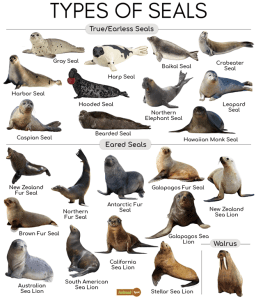TAG: GS 3: ECOLOGY AND ENVIRONMENT
THE CONTEXT: Scientists and Indigenous leaders team up to conserve seals and an ancestral way of life at Yakutat, Alaska
EXPLANATION:
Historical Context of Seal Hunting in Yakutat
- Five centuries ago, Tlingit hunters in southeast Alaska’s Yakutat fjord utilized bone-tipped harpoons to hunt harbor seals near the Sít Tlein (Hubbard) glacier.
- These hunts were deeply intertwined with their spirituality, as hunters communicated with the seals and the glacier’s spirit, Sít Tlein, to respectfully seek the seals as sustenance.
- The Tlingit elders recount how their ancestors navigated the dangers posed by the glacier’s calving, balancing the need for food with reverence for nature.
- Migrating clans, including the Eyak, Ahtna, and Tlingit tribes, settled in the Yakutat fjord as the glacier retreated.
- These communities adapted their hunting practices to stay close to the ice floe rookery, a crucial habitat for seal birthing each spring.
- Clan leaders managed hunting activities to prevent overhunting, embodying Indigenous values of respect and balance with nature.
Modern Subsistence and Cultural Practices
- Today, the Tlingit community of Yakutat, with about 300 residents, maintains its subsistence lifestyle by harvesting over 100 species of fish, birds, sea mammals, land game, and plants.
- Harbor seals, or “tsaa,” remain central to their diet, with traditional recipes used to prepare the meat and blubber for everyday meals and memorial potlatch feasts.
Crisis and Response
- Decline of Seal Population
- The Gulf of Alaska’s harbor seal population suffered a dramatic decline due to commercial hunting in the mid-20th century.
- Despite the cessation of commercial hunting in 1972, the seals have not recovered, largely due to the impacts of climate change on ocean temperatures and fish populations crucial to the seals’ diet.
- The population saw an 80-90% decline, exacerbated by cycles of the Pacific Decadal Oscillation that further reduce fish availability.
- Collaborative Conservation Efforts
- In response to the decline, the Yakutat community has significantly reduced seal hunting, aligning with ancestral conservation practices.
- Harvest numbers dropped from 640 seals in 1996 to 345 in 2015. Modern efforts focus on minimal disturbance at the ice floe rookery to allow seals to raise their pups safely.
- Collaborative management involves working with the Alaska Department of Fish and Game, the National Oceanic and Atmospheric Administration, and the Alaska Native Harbor Seal Commission, combining Indigenous knowledge with scientific expertise to monitor and protect the seal population.
Archaeological and Historical Research
- The village of Tlákw.aan, established around 1450 A.D., offers insights into pre-contact Indigenous life and sustainable sealing practices.
- Archaeological excavations in 2014 revealed artifacts such as harpoon points, stone oil lamps, and skin scrapers, alongside harbor seal bones, predominantly from young seals.
- These findings confirm the historical reliance on seals and the sustainable methods employed by the Ahtna and Eyak inhabitants.
Impact of Commercial Sealing
- Following the US purchase of Alaska in 1867, traditional sealing practices were disrupted by the Alaska Commercial Company’s demand for seal skins and oil.
- From 1870 to 1915, Yakutat became a key site for commercial sealing, drastically altering the community’s way of life.
- Archaeological evidence from Keik’uliyáa, the largest hunting camp, shows the integration of trade goods and capitalist influences, marking a significant cultural shift.
Modern Adaptations and Future Prospects
- The Yakutat community has adapted by diversifying their diet and implementing conservation measures to protect the harbor seals.
- Their reduced hunting efforts are complemented by active participation in monitoring and co-managing the seal population, aiming to balance subsistence needs with ecological sustainability.
Cultural Recommitment and Environmental Stewardship
- Yakutat Natives are recommitting to ancestral principles of respect and balance, emphasizing spiritual and ecological regard for seals.
- This approach is crucial for ensuring the survival of the seal population and the continuation of the cultural and subsistence traditions that define the Yakutat community’s way of life.
Seals
- Pinnipeds commonly known as seals, are a widely distributed and diverse clade of carnivorous, fin-footed, semiaquatic, mostly marine mammals.
- They comprise the extant families Odobenidae (whose only living member is the walrus), Otariidae (the eared seals: sea lions and fur seals), and Phocidae (the earless seals, or true seals), with 34 extant species and more than 50 extinct species described from fossils.
- While seals were historically thought to have descended from two ancestral lines, molecular evidence supports them as a monophyletic group (descended from one ancestor).
- Pinnipeds belong to the suborder Caniformia of the order Carnivora; their closest living relatives are musteloids (weasels, raccoons, skunks and red panda), having diverged about 50 million years ago.
- Seals range in size from the 1 m (3 ft 3 in) and 45 kg (100 lb) Baikal seal to the 5 m (16 ft) and 3,200 kg (7,100 lb) southern elephant seal.
- Several species exhibit sexual dimorphism.
- They have streamlined bodies and four limbs that are modified into flippers.
- Though not as fast in the water as dolphins, seals are more flexible and agile.
- Otariids primarily use their front limbs to propel themselves through the water, while phocids and walruses primarily use their hind limbs for this purpose.
- Otariids and walruses have hind limbs that can be pulled under the body and used as legs on land.
- By comparison, terrestrial locomotion by phocids is more cumbersome.
- Otariids have visible external ears, while phocids and walruses lack these.
- Pinnipeds have well-developed senses—their eyesight and hearing are adapted for both air and water, and they have an advanced tactile system in their whiskers or vibrissae.
- Some species are well adapted for diving to great depths. They have a layer of fat, or blubber, under the skin to keep warm in cold water, and, other than the walrus, all species are covered in fur.


